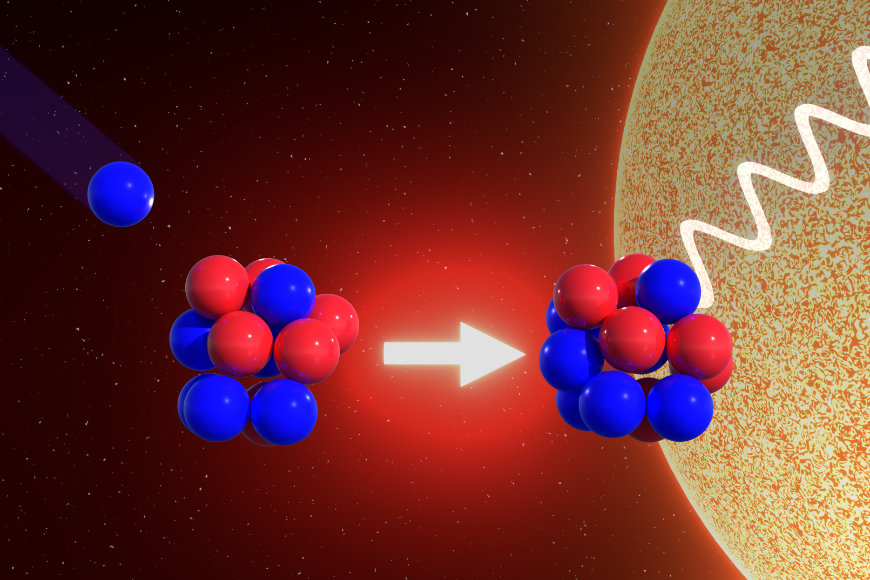A new look at hydrogen burning in massive stars
The nuclear reaction that occurs inside massive stars has now been investigated at the Dresden Felsinkler accelerator. It is the first step of the so-called CNO cycle and has already been researched using accelerators. But in the new study, the team encountered a surprise: the previously accepted value for the cross section may need to be corrected.
|
A new look at the well-known nuclear reaction: When a carbon nucleus collides with a hydrogen nucleus, the nitrogen isotope-13 is formed and gamma radiation is emitted. picture: Bernd Schröder/HZDR [Groansicht] |
“We took a closer look at the well-known nuclear reaction that is important for the formation of elements in massive stars and is also one of the oldest reactions examined in the laboratory using accelerators: the collision of a hydrogen nucleus with a carbon nucleus, as a result of which the nitrogen isotope 13 is created and gamma radiation is released, which is the first step of the so-called cycle CNO, also known as the Bethe-Weizscker cycle. We were particularly interested in the cross section of this interaction that provides information about the probability of its occurrence,” says Professor Daniel Bimmerer of the Institute for Radiation Physics at the Helmholtz Center Dresden-Rossendorf (HZDR).
A team of Italian, Hungarian, Scottish and German scientists at the Felsenkeller underground laboratory has now determined this parameter with unprecedented precision. The surprising result: the previously accepted value should be corrected downward by about 25 percent. The result indicates that the CNO cycle burnout took longer than previously thought, and that the emission of 13N solar neutrinos occurs, on average, closer to the center of the Sun than expected. The new data also allows for more accurate theoretical predictions of the 12C/13C carbon isotope ratio in stars, which in turn helps test and improve models of processes within them.
Stars get their energy from hydrogen fusing to form helium. Depending on the mass of the celestial body, different processes are known for this. In low-mass stars like our Sun, it is the so-called proton-proton chain that fires in the first place. However, in massive stars, strong gravitational forces compress hydrogen nuclei so much that high temperatures prevail here. This allows the hydrogen nucleus to also interact with the carbon nuclei. Although this is only 2% of the interstellar matter from which stars are formed, this concentration is sufficient to start and keep the CNO cycle running. It acts as a catalyst: it speeds up the reaction without consuming itself. The net reaction in the end is the same as the proton-proton cycle: the fusion of hydrogen with helium.
But in stars with a CNO cycle, this reaction occurs much faster. “We use discs made of tantalum on which carbon has been deposited as targets. We call them protons that come from a 5-meV Pelletron accelerator and cover a relatively wide energy range. We can produce gamma quanta generated by the interaction with 20 sensitive germanium detectors,” says Bimmerer, describing the experimental procedure. Ultra pure.
The underground Felsenkeller laboratory at the Ballonchengrund, jointly operated by HZDR and TU Dresden, is ideal for such measurements. A 45-metre-thick layer of rock in the former ice storage tunnel of the Dresden Felsinkler brewery protects the detectors from cosmic radiation, whose background signals can distort the results.
The current work is also a good example of cross-European collaboration in the astrophysics community: a PhD student from the University of Padua conducted research at Felsenkeller for six months during the experiment. The participation of additional measurement guests from Italy, Hungary and Scotland was financially supported by the European Union as part of the ChETEC-INFRA project.
The team presents the results in a specialized article published in the journal Physical review c He showed up.
|
|
|
|
|
|

“Tv expert. Hardcore creator. Extreme music fan. Lifelong twitter geek. Certified travel enthusiast. Baconaholic. Pop culture nerd. Reader. Freelance student.”








